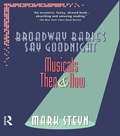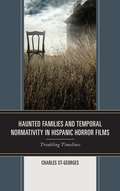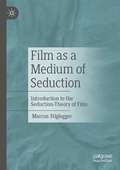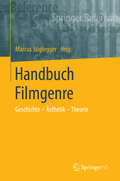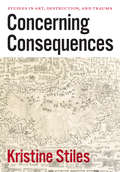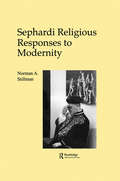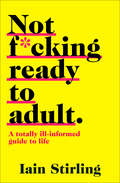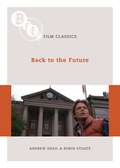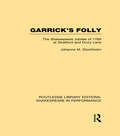- Table View
- List View
Broadway Babies Say Goodnight: Musicals Then and Now
by Mark SteynThe glorious tradition of the Broadway musical from Irving Berlin to Jerome Kern and Rodgers and Hammerstein to Stephen Sondheim. And then . . . Cats and Les Miz. Mark Steyn's Broadway Babies Say Goodnight is a sharp-eyed view of the whole span of Broadway musical history, seven decades of brilliant achievements the best of which are among the finest works American artists have made. Show Boat, Oklahoma!, Carousel, Gypsy, and more. In an energetic blend of musical history, analysis, and backstage chat, Mark Steyn shows us the genius behind the 'simple' musical, and asks hard questions about the British invasion of Broadway and the future of the form. In this delicious book he gives us geniuses and monsters, hits and atomic bombs, and the wonderful stories that prove show business is a business which -- as the song goes --there's no business like.
Broadway Babies Say Goodnight: Musicals Then and Now
by Mark SteynThe glorious tradition of the Broadway musical from Irving Berlin to Jerome Kern and Rodgers and Hammerstein to Stephen Sondheim. And then . . . Cats and Les Miz. Mark Steyn's Broadway Babies Say Goodnight is a sharp-eyed view of the whole span of Broadway musical history, seven decades of brilliant achievements the best of which are among the finest works American artists have made. Show Boat, Oklahoma!, Carousel, Gypsy, and more. In an energetic blend of musical history, analysis, and backstage chat, Mark Steyn shows us the genius behind the 'simple' musical, and asks hard questions about the British invasion of Broadway and the future of the form. In this delicious book he gives us geniuses and monsters, hits and atomic bombs, and the wonderful stories that prove show business is a business which -- as the song goes --there's no business like.
Haunted Families And Temporal Normativity In Hispanic Horror Films: Troubling Timelines (PDF)
by Charles St-GeorgesThis book examines the interactions between ghosts and families in three recent horror films from the Spanish-speaking world that, rather than explicitly referencing recent political violence, speak to the societal conditions and everyday normative violence that serve as preconditions for political violence. This study deconstructs intersectional processes of racially and sexually normative subject formation-and its oppositional other, ghostly erasure-that are framed by a common temporal logic, wherein full citizenship is contingent upon a nation's dominant notions of contemporaneousness and whether individuals properly inhabit prescriptive timelines of (re)productivity. St-Georges's study explores ways in which ghosts and families are manipulated in each national imaginary as a strategy for negotiating volatility within symbolic order: a tactic that can either naturalize or challenge normative discourses. As a literary and cinematic trope, ghosts are particularly useful vehicles for the exploration of national imaginaries and the dominant or competing cultural attitudes towards a country's history, and thus, the articulation of a present political reality. The rhetorical figure of the family is also key in this process as a mechanism for expressing national allegories, for expressing generational anxieties about a nation's relationship to time, and for organizing societies and social subjects as such, interpellating them into or excluding them from national imaginaries. By proposing these specific coordinates-ghosts and families-and by mapping their relationship between Spain and Latin America, Troubling Timelines proposes a study of a temporal framework that, besides bridging the traditional area-studies divide across the Atlantic, creates a space for interdisciplinary inquiry while also responding to increasing demand for studies that focus on intersectionality.
Mapping Precarity in Contemporary Cinema and Television: Chronotopes of Anxiety, Depression, Expulsion/Extinction
by Francesco SticchiThis book examines a corpus of films and TV series released since the global financial crisis, addressing them as emblematic expressions of our age of precarity. The analysis of the motifs and characters of these case studies is built around notions originating from Mikhail Bakhtin’s literary theory and, in particular, the concept of chronotope, affirming the material and dynamic connection between form and content in artistic experience. This book observes how precarious lives are enacted in forms of spatio-temporal compositions which carry conceptual and ethical challenges for their viewers. This book falls within the film-philosophy framework and, although primarily directed to an academic audience, it provides an interdisciplinary account of the notion of cinematic precarity. It puts the embodied analysis of viewers’ ethical participation in close dialogical relationship with a philosophical and sociological examination of current dynamics of inequality and exclusion.
Melancholy Emotion in Contemporary Cinema: A Spinozian Analysis of Film Experience (Routledge Advances in Film Studies)
by Francesco SticchiThis work outlines a new methodology for film analysis based on the radical materialist thought of Baruch Spinoza, re-evaluating contemporary cognitive media theory and philosophical theories on the emotional and intellectual aspects of film experience. Sticchi’s exploration of Spinozian philosophy creates an experiential constructive model to blend the affective and intellectual aspects of cognition, and to combine it with different philosophical interpretations of film theory. Spinoza’s embodied philosophy rejected logical and ethical dualisms, and established a perfect parallelism between sensation and reason and provides the opportunity to address negative emotions and sad passions without referring exclusively to traditional notions such as catharsis or sublimation, and to put forth a practical/embodied notion of Film-Philosophy. This new analytical approach is tested on four case studies, films that challenge the viewer’s emotional engagement since they display situations of cosmic failure and depict controversial and damaged characters: A Serious Man (2009); Melancholia (2011); The Act of Killing (2012) and Only Lovers Left Alive (2013). This book is an important addition to the literature in Film Studies, particularly in Cognitive Film Theory and Philosophy of Film. Its affective and semantic analyses of film experience (studies of embodied conceptualisation), connecting Spinoza’s thought to the analysis of audiovisual media, will also be of interest to Philosophy scholars and in academic courses of film theory, film-philosophy and cognitive film studies.
Melancholy Emotion in Contemporary Cinema: A Spinozian Analysis of Film Experience (Routledge Advances in Film Studies)
by Francesco SticchiThis work outlines a new methodology for film analysis based on the radical materialist thought of Baruch Spinoza, re-evaluating contemporary cognitive media theory and philosophical theories on the emotional and intellectual aspects of film experience. Sticchi’s exploration of Spinozian philosophy creates an experiential constructive model to blend the affective and intellectual aspects of cognition, and to combine it with different philosophical interpretations of film theory. Spinoza’s embodied philosophy rejected logical and ethical dualisms, and established a perfect parallelism between sensation and reason and provides the opportunity to address negative emotions and sad passions without referring exclusively to traditional notions such as catharsis or sublimation, and to put forth a practical/embodied notion of Film-Philosophy. This new analytical approach is tested on four case studies, films that challenge the viewer’s emotional engagement since they display situations of cosmic failure and depict controversial and damaged characters: A Serious Man (2009); Melancholia (2011); The Act of Killing (2012) and Only Lovers Left Alive (2013). This book is an important addition to the literature in Film Studies, particularly in Cognitive Film Theory and Philosophy of Film. Its affective and semantic analyses of film experience (studies of embodied conceptualisation), connecting Spinoza’s thought to the analysis of audiovisual media, will also be of interest to Philosophy scholars and in academic courses of film theory, film-philosophy and cognitive film studies.
Film als Medium der Verführung: Einführung in die Seduktionstheorie des Films
by Marcus StigleggerDie Seduktionstheorie definiert den Film im weiteren Sinne als ein Medium der Verführung, basierend auf dem französischen Begriff der séduction. Es handelt sich um einen von kontinentaler Philosophie und klassischer Filmtheorie geprägten theoretischen Ansatz, mit dem ein dreistufiges Analysemodell verknüpft ist. Das Buch führt in die theoretischen Grundlagen ein und stellt anhand unterschiedlicher klassischer und aktueller Beispiele aus der Filmgeschichte mögliche Analyseansätze vor.
Film as a Medium of Seduction: Introduction to the Seduction-Theory of Film
by Marcus StigleggerThe seduction-theory defines film in a broader sense as a medium of seduction, based on the French concept of séduction. It is a theoretical approach influenced by continental philosophy and classical film theory, linked to a three-stage analytical model. The book introduces the theoretical foundations and, using various classical and contemporary examples from film history, presents a genuine method of film analysis.
Handbuch Filmgenre: Geschichte – Ästhetik – Theorie (Springer Reference Geisteswissenschaften Ser.)
by Marcus StigleggerDas vorliegende Handbuch bietet einen umfassenden Überblick über den Stand der Filmgenreforschung. Es werden sowohl die Definitionen und die Begriffsgeschichte umfassend dargestellt, verschiedene Theorien und Ansätze, historische und lokale Perspektiven vorgestellt, als auch einzelne Filmgenres wie Western, Kriminalfilm, Gangsterfilm, Thriller, Science Fiction, Horror, Fantasy, Komödie, Melodram, Abenteuerfilm, Musical, Kriegsfilm bis hin zum erotischen Film in Einzelstudien analysiert.In dieser Multiperspektivik bildet der Band die Phänomenologie von Filmgenres quer durch die Filmgeschichte als einen umfassenden Diskurs ab, der durch Beiträge von führenden Vertreterinnen und Vertretern der deutschsprachigen Genreforschung nah an internationalen Filmbeispielen diskutiert wird.
Mediale Topographien: Beiträge zur Medienkulturgeographie
by Marcus Stiglegger Anton EscherFilmwissenschaftliche Analyse und die Methodik der Kulturgeographie werden in diesem neuartig perspektivierten Band zusammengeführt, um die medialen Topographien und Raumentwürfe des narrativen Films zu erkunden. Neben definitorischen Kapiteln zu Grundbegriffen der Filmgeographie finden sich Reflexionen zu den mythischen Räumen des Films, zur medialen Konstruktion ikonischer Orte (Casablanca, Tanger) sowie über die filmische Adaption von Grenz-Räumen und Konflikten (USA/Mexiko).
Dystopien in Serie
by Marcus Stiglegger Christian Hißnauer Thomas Klein Lioba SchlösserSerielle Dystopien sind omnipräsent; sei es in der Literatur, im Spielfilm, der Fernseh- bzw. Streamingserie oder auch im Videogame. Das Buch verbindet ein wesentliches Erzählverfahren (die Serie) mit gerade kontrovers diskutierten Themen (u.a. Diversity, Covid 19) und dem Genre ihrer medialen Verhandlung. Die Serialität dystopischer Erzählungen ist ein transmediales Phänomen. Der Band geht der Frage nach, wie sich negative Zukunftsvorstellungen, aber auch kontrafaktische Vergangenheitsentwürfe medienspezifisch darstellen, wie sie darüber hinaus im Zuge der Medienkonvergenz größere Erzähluniversen herausbilden. Im Mittelpunkt stehen dabei vor allem Überlegungen, ob sich die serielle Form in besonderer Weise dafür eignet, von dystopischen Gesellschaftsvisionen zu erzählen.
Concerning Consequences: Studies in Art, Destruction, and Trauma
by Kristine StilesKristine Stiles has played a vital role in establishing trauma studies within the humanities. A formidable force in the art world, Stiles examines the significance of traumatic experiences both in the individual lives and works of artists and in contemporary international cultures since World War II. In Concerning Consequences, she considers some of the most notorious art of the second half of the twentieth century by artists who use their bodies to address destruction and violence. The essays in this book focus primarily on performance art and photography. From war and environmental pollution to racism and sexual assault, Stiles analyzes the consequences of trauma as seen in the works of artists like Marina Abramovic, Pope.L, and Chris Burden. Assembling rich intellectual explorations on everything from Paleolithic paintings to the Bible’s patriarchal legacies to documentary images of nuclear explosions, Concerning Consequences explores how art can provide a distinctive means of understanding trauma and promote individual and collective healing.
Concerning Consequences: Studies in Art, Destruction, and Trauma
by Kristine StilesKristine Stiles has played a vital role in establishing trauma studies within the humanities. A formidable force in the art world, Stiles examines the significance of traumatic experiences both in the individual lives and works of artists and in contemporary international cultures since World War II. In Concerning Consequences, she considers some of the most notorious art of the second half of the twentieth century by artists who use their bodies to address destruction and violence. The essays in this book focus primarily on performance art and photography. From war and environmental pollution to racism and sexual assault, Stiles analyzes the consequences of trauma as seen in the works of artists like Marina Abramovic, Pope.L, and Chris Burden. Assembling rich intellectual explorations on everything from Paleolithic paintings to the Bible’s patriarchal legacies to documentary images of nuclear explosions, Concerning Consequences explores how art can provide a distinctive means of understanding trauma and promote individual and collective healing.
Concerning Consequences: Studies in Art, Destruction, and Trauma
by Kristine StilesKristine Stiles has played a vital role in establishing trauma studies within the humanities. A formidable force in the art world, Stiles examines the significance of traumatic experiences both in the individual lives and works of artists and in contemporary international cultures since World War II. In Concerning Consequences, she considers some of the most notorious art of the second half of the twentieth century by artists who use their bodies to address destruction and violence. The essays in this book focus primarily on performance art and photography. From war and environmental pollution to racism and sexual assault, Stiles analyzes the consequences of trauma as seen in the works of artists like Marina Abramovic, Pope.L, and Chris Burden. Assembling rich intellectual explorations on everything from Paleolithic paintings to the Bible’s patriarchal legacies to documentary images of nuclear explosions, Concerning Consequences explores how art can provide a distinctive means of understanding trauma and promote individual and collective healing.
Concerning Consequences: Studies in Art, Destruction, and Trauma
by Kristine StilesKristine Stiles has played a vital role in establishing trauma studies within the humanities. A formidable force in the art world, Stiles examines the significance of traumatic experiences both in the individual lives and works of artists and in contemporary international cultures since World War II. In Concerning Consequences, she considers some of the most notorious art of the second half of the twentieth century by artists who use their bodies to address destruction and violence. The essays in this book focus primarily on performance art and photography. From war and environmental pollution to racism and sexual assault, Stiles analyzes the consequences of trauma as seen in the works of artists like Marina Abramovic, Pope.L, and Chris Burden. Assembling rich intellectual explorations on everything from Paleolithic paintings to the Bible’s patriarchal legacies to documentary images of nuclear explosions, Concerning Consequences explores how art can provide a distinctive means of understanding trauma and promote individual and collective healing.
Concerning Consequences: Studies in Art, Destruction, and Trauma
by Kristine StilesKristine Stiles has played a vital role in establishing trauma studies within the humanities. A formidable force in the art world, Stiles examines the significance of traumatic experiences both in the individual lives and works of artists and in contemporary international cultures since World War II. In Concerning Consequences, she considers some of the most notorious art of the second half of the twentieth century by artists who use their bodies to address destruction and violence. The essays in this book focus primarily on performance art and photography. From war and environmental pollution to racism and sexual assault, Stiles analyzes the consequences of trauma as seen in the works of artists like Marina Abramovic, Pope.L, and Chris Burden. Assembling rich intellectual explorations on everything from Paleolithic paintings to the Bible’s patriarchal legacies to documentary images of nuclear explosions, Concerning Consequences explores how art can provide a distinctive means of understanding trauma and promote individual and collective healing.
Concerning Consequences: Studies in Art, Destruction, and Trauma
by Kristine StilesKristine Stiles has played a vital role in establishing trauma studies within the humanities. A formidable force in the art world, Stiles examines the significance of traumatic experiences both in the individual lives and works of artists and in contemporary international cultures since World War II. In Concerning Consequences, she considers some of the most notorious art of the second half of the twentieth century by artists who use their bodies to address destruction and violence. The essays in this book focus primarily on performance art and photography. From war and environmental pollution to racism and sexual assault, Stiles analyzes the consequences of trauma as seen in the works of artists like Marina Abramovic, Pope.L, and Chris Burden. Assembling rich intellectual explorations on everything from Paleolithic paintings to the Bible’s patriarchal legacies to documentary images of nuclear explosions, Concerning Consequences explores how art can provide a distinctive means of understanding trauma and promote individual and collective healing.
Sephardi Religious Responses/M
by StillmanFirst Published in 1995. Routledge is an imprint of Taylor & Francis, an informa company.
Sephardi Religious Responses/M
by StillmanFirst Published in 1995. Routledge is an imprint of Taylor & Francis, an informa company.
Goosebumps: Revenge of the Lawn Gnomes (PDF)
by R. L. StineKEEP OFF THEIR GRASS!Two pink flamingos. A whole family of plaster skunks. Joe Burton's dad loves tacky lawn ornaments. But when he brings home two ugly lawn gnomes, the trouble begins. Late at night. When everyone's sleeping. Someone's creeping in the garden. Whispering nasty things. Smashing melons. Squashing tomatoes. No way two dumb old lawn ornaments with pointy hats could be causing all the trouble... Is there?
Not F*cking Ready To Adult: A Totally Ill-informed Guide To Life
by Iain StirlingComedian Iain Stirling is best known as the brilliantly funny voice of the BAFTA-award winning smash hit Love Island. Despite his many accolades, and his mum telling him he’s her ‘special little soldier’ every day, Iain still struggles with everyday adult life. What a textbook millennial.
Back to the Future (BFI Film Classics)
by Robin Stoate Andrew ShailThis compelling study places 'Back to the Future' in the context of Reaganite America, discusses Robert Zemeckis's film-making technique and its relationship to the 'New New Hollywood', explores the film's attitudes to teen culture of the 1950s and 1980s and its representation of science, atomic power and time travel.
Back to the Future (BFI Film Classics)
by Robin Stoate Andrew ShailThis compelling study places 'Back to the Future' in the context of Reaganite America, discusses Robert Zemeckis's film-making technique and its relationship to the 'New New Hollywood', explores the film's attitudes to teen culture of the 1950s and 1980s and its representation of science, atomic power and time travel.
Garrick's Folly: The Shakespeare Jubilee of 1769 at Stratford and Drury Lane (Routledge Library Editions: Shakespeare in Performance)
by Johanne M. StochholmThe great Shakespeare Jubilee festival was held at Stratford, under the direction of David Garrick. The occasion was the dedication of the new town hall and the presentation by Garrick of a statue of Shakespeare. Immense interest, enthusiasm, and controversy were aroused by the plans, which involved not only theatrical and rhetorical festivities but fireworks, processions and a horserace. This book was originally published in 1964 to coincide with the 400th anniversary of Shakespeare’s birth. It describes the festival, which touched heights of success and depths of disaster, its impact on Stratford, its after effects in London, especially theatrical London, where rival managers tried to cash in on Garrick’s idea and where Garrick turned the Stratford failure into resounding success at Drury Lane. The author quotes entertainingly from newspapers, memoirs, and plays, and illustrates her book with contemporary engravings and portraits.
Garrick's Folly: The Shakespeare Jubilee of 1769 at Stratford and Drury Lane (Routledge Library Editions: Shakespeare in Performance)
by Johanne M. StochholmThe great Shakespeare Jubilee festival was held at Stratford, under the direction of David Garrick. The occasion was the dedication of the new town hall and the presentation by Garrick of a statue of Shakespeare. Immense interest, enthusiasm, and controversy were aroused by the plans, which involved not only theatrical and rhetorical festivities but fireworks, processions and a horserace. This book was originally published in 1964 to coincide with the 400th anniversary of Shakespeare’s birth. It describes the festival, which touched heights of success and depths of disaster, its impact on Stratford, its after effects in London, especially theatrical London, where rival managers tried to cash in on Garrick’s idea and where Garrick turned the Stratford failure into resounding success at Drury Lane. The author quotes entertainingly from newspapers, memoirs, and plays, and illustrates her book with contemporary engravings and portraits.
